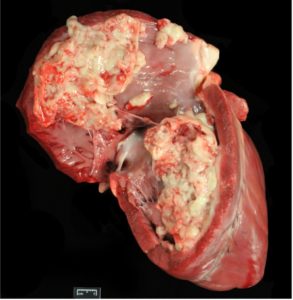A 1.5-year-old, captive, white-tailed deer buck was submitted to TVMDL for necropsy. The animal had a prolonged history of illness for at least 4 months that was not responsive to antibiotic treatment. Reported clinical signs included lethargy and rapid weight loss despite having an appetite. At necropsy, a severe endocarditis was discovered. Large amounts of suppurative material covered part of the right atrioventricular valve, coated large regions of the right ventricular and atrial endocardium, and filled most of the right ventricular lumen (see figure). Secondary changes included right ventricular hypertrophy, pericardial effusion, pulmonary and renal embolic abscesses, and rupture of a pulmonary vessel leading to hemothorax. A swab collected from the inflammatory material in the heart isolated pure colonies of Trueperella pyogenes.
Bacterial endocarditis occurs in many animal species. This disease typically develops as a sequela of bacteremia when bacteria settle and colonize heart valves. Microabrasions on the heart valves caused by friction from cardiac contraction and pre-existing valvular anomalies can create a favorable site for bacterial growth. Once the bacteria begin to proliferate on the valves, they typically form vegetative growths composed of bacteria, fibrin, protein, and inflammatory cells. In severe cases, the inflammation can extend to the endocardium. As the heart contracts, it is common for small fragments of the vegetative growths to break off and release into circulation, and these bacterial emboli can settle in other organs to form abscesses.
There are many potential causes of endocarditis. In cattle and deer, Trueperella pyogenes tends to be the most commonly isolated bacteria. In some cases, a primary source of infection such as a cranial abscess, liver abscess, etc. is found. No such lesion or other cause of preceding septicemia was identified in this case.
For more information about TVMDL’s test catalog, visit tvmdl.tamu.edu or call 1.888.646.5623.
